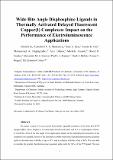Files in this item
Wide-bite-angle disphosphine ligands in thermally activated delayed fluorescent copper(I) complexes : impact on the performance of electroluminescence applications
Item metadata
| dc.contributor.author | Li, Chenfei | |
| dc.contributor.author | Mackenzie, Campbell Frank Ross | |
| dc.contributor.author | Said, Said A. | |
| dc.contributor.author | Pal, Amlan Kumar | |
| dc.contributor.author | Haghighatbin, Mohammed A. | |
| dc.contributor.author | Babaei, Azin | |
| dc.contributor.author | Sessolo, Michele | |
| dc.contributor.author | Cordes, David Bradford | |
| dc.contributor.author | Slawin, Alexandra Martha Zoya | |
| dc.contributor.author | Kamer, Paul C J | |
| dc.contributor.author | Bolink, Henk | |
| dc.contributor.author | Hogan, Conor F. | |
| dc.contributor.author | Zysman-Colman, Eli | |
| dc.date.accessioned | 2022-06-30T23:39:52Z | |
| dc.date.available | 2022-06-30T23:39:52Z | |
| dc.date.issued | 2021-07-01 | |
| dc.identifier | 274588033 | |
| dc.identifier | e9664d36-8317-499a-9690-255174b6ab37 | |
| dc.identifier | 85110964922 | |
| dc.identifier | 000675430900029 | |
| dc.identifier.citation | Li , C , Mackenzie , C F R , Said , S A , Pal , A K , Haghighatbin , M A , Babaei , A , Sessolo , M , Cordes , D B , Slawin , A M Z , Kamer , P C J , Bolink , H , Hogan , C F & Zysman-Colman , E 2021 , ' Wide-bite-angle disphosphine ligands in thermally activated delayed fluorescent copper(I) complexes : impact on the performance of electroluminescence applications ' , Inorganic Chemistry , vol. Articles ASAP . https://doi.org/10.1021/acs.inorgchem.1c00804 | en |
| dc.identifier.issn | 0020-1669 | |
| dc.identifier.other | RIS: urn:4B323D2977AFFA94BFDF89BC39ACA5D5 | |
| dc.identifier.other | RIS: urn:4B323D2977AFFA94BFDF89BC39ACA5D5 | |
| dc.identifier.other | ORCID: /0000-0002-5677-5070/work/97129936 | |
| dc.identifier.other | ORCID: /0000-0002-9527-6418/work/97473277 | |
| dc.identifier.other | ORCID: /0000-0002-5366-9168/work/97473375 | |
| dc.identifier.other | ORCID: /0000-0001-7183-6022/work/97473656 | |
| dc.identifier.uri | https://hdl.handle.net/10023/25594 | |
| dc.description | Funding: C.L. thanks the Prof. & Mrs Purdie Bequests Scholarship and AstraZeneca for a PhD Studentship. The St Andrews researchers thank the Engineering and Physical Sciences Research Council (EP/M02105X/1 and EP/R035164/1) for financial support. A.K.P. acknowledges the Leverhulme Trust and the University of St Andrews for an Early Career Fellowship (ECF-2017-326). H.J.B. and M.S. acknowledge funding from the Spanish Ministry of Science, Innovation and Universities (MAT2017‐88821‐R and RYC-2016-21316, respectively). C.F.H. acknowledges the support of the Australian Research Council (ARC) Discovery grant scheme (DP200102947). | en |
| dc.description.abstract | We report a series of seven cationic heteroleptic copper(I) complexes of the form [Cu(P^P)(dmphen)]BF4, where dmphen is 2,9-dimethyl-1,10-phenanthroline and P^P is a diphosphine chelate, in which the effect of the bite angle of the diphosphine ligand on the photophysical properties of the complexes was studied. Several of the complexes exhibit moderately high photoluminescence quantum yields in the solid state, with ΦPL of up to 35%, and in solution, with ΦPL of up to 98%. We were able to correlate the powder photoluminescence quantum yields with the % Vbur of the P^P ligand. The most emissive complexes were used to fabricate both organic light-emitting diodes and light-emitting electrochemical cells (LECs), both of which showed moderate performance. Compared to the benchmark copper(I)-based LECs, [Cu(dnbp)(DPEPhos)]+ (maximum external quantum efficiency, EQEmax = 16%), complex 3 (EQEmax = 1.85%) showed a much longer device lifetime (t1/2 = 1.25 h and >16.5 h for [Cu(dnbp)(DPEPhos)]+ and complex 3 , respectively). The electrochemiluminescence (ECL) properties of several complexes were also studied, which, to the best of our knowledge, constitutes the first ECL study for heteroleptic copper(I) complexes. Notably, complexes exhibiting more reversible electrochemistry were associated with higher annihilation ECL as well as better performance in a LEC. | |
| dc.format.extent | 17 | |
| dc.format.extent | 2989536 | |
| dc.language.iso | eng | |
| dc.relation.ispartof | Inorganic Chemistry | en |
| dc.subject | Redox reactions | en |
| dc.subject | Ligands | en |
| dc.subject | Crystal structure | en |
| dc.subject | Organophosphorus compounds | en |
| dc.subject | Nuclear magnetic resonance spectroscopy | en |
| dc.subject | QD Chemistry | en |
| dc.subject | DAS | en |
| dc.subject.lcc | QD | en |
| dc.title | Wide-bite-angle disphosphine ligands in thermally activated delayed fluorescent copper(I) complexes : impact on the performance of electroluminescence applications | en |
| dc.type | Journal article | en |
| dc.contributor.sponsor | EPSRC | en |
| dc.contributor.sponsor | EPSRC | en |
| dc.contributor.sponsor | The Leverhulme Trust | en |
| dc.contributor.institution | University of St Andrews. School of Chemistry | en |
| dc.contributor.institution | University of St Andrews. EaSTCHEM | en |
| dc.identifier.doi | 10.1021/acs.inorgchem.1c00804 | |
| dc.description.status | Peer reviewed | en |
| dc.date.embargoedUntil | 2022-07-01 | |
| dc.identifier.url | https://doi.org/10.26434/chemrxiv.14046449.v1 | en |
| dc.identifier.grantnumber | EP/M02105X/1 | en |
| dc.identifier.grantnumber | EP/R035164/1 | en |
| dc.identifier.grantnumber | ECF-2017-326 | en |
This item appears in the following Collection(s)
Items in the St Andrews Research Repository are protected by copyright, with all rights reserved, unless otherwise indicated.

